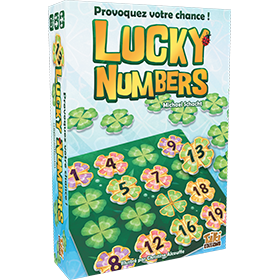luckynumbers
 At the crossroads of a Sudoku and a bingo, Lucky Numbers is a game where you will make your own luck. Be the first to complete your garden. But you must follow ONE RULE: at any time, the numbers must be arranged in ascending order in every row and column.
At the crossroads of a Sudoku and a bingo, Lucky Numbers is a game where you will make your own luck. Be the first to complete your garden. But you must follow ONE RULE: at any time, the numbers must be arranged in ascending order in every row and column.
So, Draw, Place and Organize your garden to improve your winning chances. But be careful not to give to the other players a clover that will lead them to victory!
Niver a c'hoarierien: 2 - 4
Padelezh ar bartienn: 5 mn
Kemplezhded : 1 / 5
C'hoari da luckynumbers pe da 1194 c'hoari all enlinenn.
Pellgargañ ret ebet - c'hoariit war-eeun adalek ho merdeer.
Gant ho mignoned ha miliadoù c'hoarierien/ezed en hollved.
Evit netra.

C'hoari da luckynumbers pe da 1194 c'hoari all enlinenn.
Pellgargañ ret ebet - c'hoariit war-eeun adalek ho merdeer.
Gant ho mignoned ha miliadoù c'hoarierien/ezed en hollved.
Evit netra.

Diverradenn ar reolennoù
Objective
- The objective is to make a full grid of 16 number tiles, winning the round.
- The numbers in each row must increase from left to right, and the numbers in each column must increase from top to bottom.
- You cannot have the same number twice in a row or column.
Gameplay
- Shuffle 1 set of 1-20 for each player as a pot.
- Each player starts with 4 distinct numbers in a diagonal line.
- At the beginning of each of your turns, you may either draw a random tile from the pot or take a tile from the table (if there are any).
- You may play the tile you have as long as it is higher than each tile before it in the same row and column, and lower than each tile after it in the same row and column.
- If you take a tile from the table, you must play it.
- To play a tile, you may either play it in an empty space or replace an existing tile on your grid.
- If you replace a tile on your grid, or choose to discard a drawn tile, that tile goes onto the table.
Example of a completed grid:
Variants
Setup
- Easy Setup: The first four tiles are automatically placed in ascending order from least in the top left to greatest in the bottom right.
- Michael's Setup: The first four tiles are drawn one at a time and placed one by one on the diagonal according to the player's choice.
Bruno's Variant
- If you place a tile diagonally adjacent to a tile with the same number, you immediately get another turn.
- You can take several turns in a row in this way.
Tournament Mode
- The game is played multiple times with each player getting a chance to go first.
- The winner of each round earns two points.
- The other players lose one point for each empty space on their grid.
- Highest total score wins.


